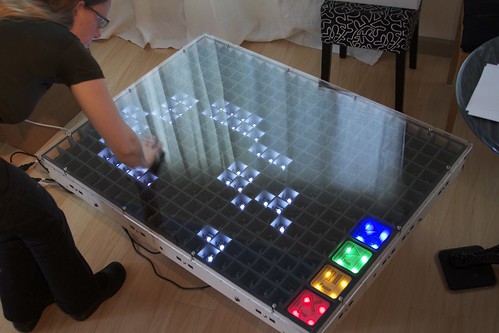"Evil Mad Scientist Laboratories" - 1 new article
Interactive Game of Life ExhibitRecently we put together this interactive Game of Life display as an educational adjunct for a new exhibit by the San Jose Museum of Art on the works of Leo Villareal. Leo primarily works with light sculptures, and we're very excited to see (and participate in) the exhibit, which opens this Friday. (If you can't see the video here, click here to visit the youtube page.)
Prior to its installation on a wall at the museum, we set the exhibit on some office boxes to try it out. As you can see, it's pretty big. The interactive surface is 32 x 44 inches, and has LEDs spaced on a 2-inch grid. There's also a "control" section on the lower right corner. Up close, the display is constructed of medium-size printed circuit boards that are tiled together. This printed circuit board was designed for the project. It's 4x8 inches and supports eight 10 mm diffused-lens LEDs. Each LED site is intended to be an independent "cell" for the game of life, and each one has its own sensor. The sensors are active infrared proximity sensors, consisting of an infrared LED (tinted blue) and infrared phototransistor (tinted black). This pair of components detects reflection off of nearby objects, such as your hand when you reach out to touch the display. An Atmel AVR ATmega164P microcontroller manages the sensors and communicates with neighboring boards. The communications protocol is a low-grade hack: a "bit bang" protocol, not so different from the scheme used on the Dropout Design/Adafruit Game of Life Kit. Communications and power are shared between neighboring boards using edge connectors. The circuit boards are snapped together with their connectors, and then installed on threaded standoffs inside the wooden frame. It takes 44 of the circuit boards to fill up the display. While each circuit board is only moderately complex, the set of boards adds up quickly to about about 3000 electronic components and 10,000 solder joints. Each board draws up to 200 mA of current at 5 V to run the processor, LEDs, and sensors, so the full set of boards draws up to 8.8 A. Because the edge connectors are not rated for currents this high, the display is actually separately powered in three sections, tied together by the common ground of the power supplies. The individual cells of the display are isolated in a latticework 1.5 inches tall, made of black Depron foam. (Aside: Depron is amazing material. It's a fairly rigid polystyrene, much like the core of standard foamboard. It's remarkably rigid for its weight, relatively inexpensive, and cuts faster than almost anything else either with a hobby knife or laser cutter.) The latticework is necessary not only to define the cells visually, but also to prevent crosstalk of the infrared sensors. The four control "buttons" on the lower right (Next Step, Run, Pause, Clear) are constructed on two of the circuit boards, constructed identically to the others except for their LED colors: These colored sections illuminate an engraved acrylic overlay that has the human-readable button text; the overlay is transparent to infrared, and only minor software changes are necessary to configure these sections as control buttons rather than cells. The downside of having so many independent boards: Each of the 44 boards had to be programmed individually. Fortunately each board has an accessible AVR ISP header, even with the lattice installed. The top cover is 3/8" thick clear acrylic, 34 x 46 inches. We had it made for us by conventional routing. It's held in place by a few 1/4-20 button socket cap screws that connect to nuts in the wooden frame. And that about covers it. The Leo Villareal exhibit starts this week at SJMoA. If you haven't seen our video of this yet, please check it out. If you haven't played with Conway's Game of Life, that's definitely worth some time. You might start with a basic simulator and check out some of the more interesting details when you're ready. More Recent Articles |
Click here to safely unsubscribe now from "Evil Mad Scientist Laboratories" or change your subscription or subscribe
Unsubscribe from all current and future newsletters powered by FeedBlitz
| Your requested content delivery powered by FeedBlitz, LLC, 9 Thoreau Way, Sudbury, MA 01776, USA. +1.978.776.9498 |













No comments:
Post a Comment